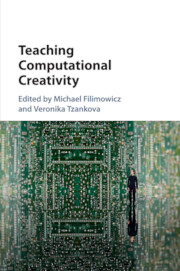Book contents
- Teaching Computational Creativity
- Teaching Computational Creativity
- Copyright page
- Contents
- Figures
- Tables
- Notes on Contributors
- Acknowledgments
- Introduction: Pedagogies at the Intersection of Disciplines
- PART I NEW FOUNDATIONS
- PART II CODE AS MEDIUM
- PART III PHYSICAL{LY} COMPUTING
- PART IV ONLINE LEARNING
- PART V CRITICAL PEDAGOGY
- PART VI TRANSDISCIPLINARY
- Interviews
- Afterword: Toward a Curricular Synthesis
- Index
- References
PART VI - TRANSDISCIPLINARY
Published online by Cambridge University Press: 04 July 2017
- Teaching Computational Creativity
- Teaching Computational Creativity
- Copyright page
- Contents
- Figures
- Tables
- Notes on Contributors
- Acknowledgments
- Introduction: Pedagogies at the Intersection of Disciplines
- PART I NEW FOUNDATIONS
- PART II CODE AS MEDIUM
- PART III PHYSICAL{LY} COMPUTING
- PART IV ONLINE LEARNING
- PART V CRITICAL PEDAGOGY
- PART VI TRANSDISCIPLINARY
- Interviews
- Afterword: Toward a Curricular Synthesis
- Index
- References
Summary
Contemporary design problems continuously challenge us to think about new skills, methods, tools, and techniques that often cannot be addressed with the expertise of a single discipline. Design problems have always been multifaceted and complex. But compared to the past, global challenges such as social inequality, environmental pollution, food scarcity, and climate change have had cascading effects on local conditions, demanding artists and designers to be more agile and aware of the social, cultural, and political realities of their times. In this chapter, I propose ways for augmenting design pedagogy to embrace a broader understanding of design that can address these challenges. Instead of reinforcing template paradigms used to educate the conventional design professions – such as product design, architecture, or graphic design – I propose a literacy-oriented pedagogy that is centered around acquiring knowledge, methods, and skills developed across different disciplines. I suggest that tool-making methods, computational thinking, or research-oriented learning are literacies that cannot be grasped from a singular approach; instead, they have to be studied as interdisciplinary foundational domains of knowledge that help designers orient their interests, find their own voices, and decide what skills to specialize in.
- Type
- Chapter
- Information
- Teaching Computational Creativity , pp. 257 - 292Publisher: Cambridge University PressPrint publication year: 2017



